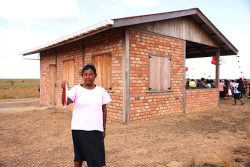Q. After the recent Market Day at Mocha you advocated that farmers and agro processors be afforded a Market and processing a packaging facilities. Some may say that the scale of their operations may not, as yet, warrant that kind of investment. Can you comment on this?
A: For the last fifty five years we have been asking people to plant, to produce and to grow local. Farmers have produced and there is no market………. with the exception of rice, that is. Now farmers are reluctant to plant. The farmers in Mocha/Arcadia have the acreage. Perhaps a medium-sized market outlet may be appropriate. However, the farmers remain hesitant. During the first and second, Market Days some farmers were reluctant to participate. However, once farmers can see that markets are there production will increase.
Q: Are you saying that this should be a government investment or a private enterprise pursuit and could you ‘flesh out’ a bit more what you have in mind?
A: The question here is who should fund the market? I believe that the government should fund the market in the medium term. In the short term it should be NDC and the people who are involved presently. Over the next two to three years, the government can established a market friendly- environment. It does not have to be a a fixed permanent structure. Farmers markets are usually open places where people can go from place to place………..like the Vendors Arcade. It must be attractive and secure. There is no one model here. We have to move to that point. Government should invest in that Market. The people themselves can invest in the facility.
Q. We have heard of challenges like the flooding of the land and land lease challenges, wild animals, roads etc. Is the Cooperative disposed to tackling those problems?
A: These are not intractable challenges. There should be inputs from both government and people here. With regard to flooding that can be controlled by continually clearing the kokers, outfalls and drains. The farmers cannot afford to do that. The farmers and the community as a whole can clean their canals110 and drains. Not so long ago that used to be a Sunday morning activity. We also need to look at climate-smart options. With the best of intentions we may have flooding. so we have to come up with climate smart solutions. The farmers themselves will have to adopt those solutions. That would be the Cooperative’s investment. Some of the solutions are obvious. The farmers will have to use raised beds for perishable vegetables. This is happening elsewhere. There are other solutions like aerial planting. I’ve seen it in different countries and it is working well. There are other solutions like the selection of crops and a sequence in timing of planting. You have to plan when you are going to plant so that you can be in sync with nature and season.
Aquaponics and hydroponics, are ways of raising beds to alleviate flooding. These are all climate – smart solutions. Climate change is an issue that farmers have to take into consideration, it is not just flooding. There are issues with salt water intrusion. When it gets dry salt water begins to come in.
Q: Last month’s Market Day was pretty impressive. Would you say that Mocha/Arcadia is now an agricultural hub?
A: It is an agriculture hub, but I would like to see it as an agri penoreal meaning that it is not just primary production that is going to go on there but also secondary production. There are lots of people in processing. There are linkages being established among various industries. We have to move primary production and we have to move into many other areas and the interesting thing is that we have the technology available.
At the University of Guyana we have done so many things that have been successful. It is not that these things we done elsewhere. We have not been able to get the farmers to adopt the technology. One of the main reasons for this is that the people we are training at UG and the Guyana School of Agriculture are not hitting the ground. So if one of every ten or twenty farmers is a UG or GSA graduate can you imagine the kind of development that would go on? The graduates have not been hitting the ground as I expected and I am very disappointed. A lot of it has to do with the way in which the economy is structured. At least 50% of the trained people must hit the ground running. The government has to make this it possible. They must not only hit the ground as Advisors. They must hit the ground as producers.
Q: What are the sorts of technology that we need to accelerate the process?
A: Improved storage production facilities; multi-nutrient blocks for sheep and beef. This system could involve many different tiers of entrepreneurship? So, for example, this silage production could be a standalone or an integrated process. The silage example could be like the water you purchase. The trucks drive up and deliver bottles of water and you gIve them the empty bottles, it is a roll on roll off system. That is a system I used in Barbados and it is amazing, that I could not get done here, that I get down there. What I discovered, is that all most all the farmers I was working with in Barbados have degrees of some kind, they are highly trained, so when I tell them about something I tell them about something it’s very easy for them to adopt , but it was not home. These are all technologies we have in Guyana.
I introduced the technology suppressed the storage in a forty five gallon drum, to make silage in a forty five gallon drum with an automatic press. Because no young person and let alone adults or old persons are going to jump up and down to compress solids in drum. They will not do, we tried and it was a waste of time. So once I got to Barbados I know right away they will not do it and I introduced automated press , in Barbados and in Belize, but not in Guyana.








